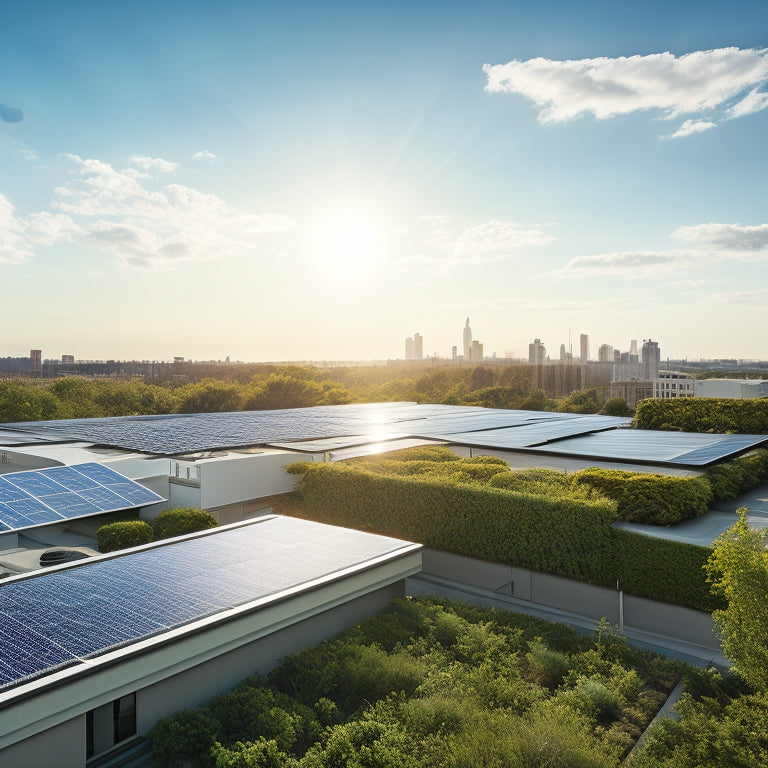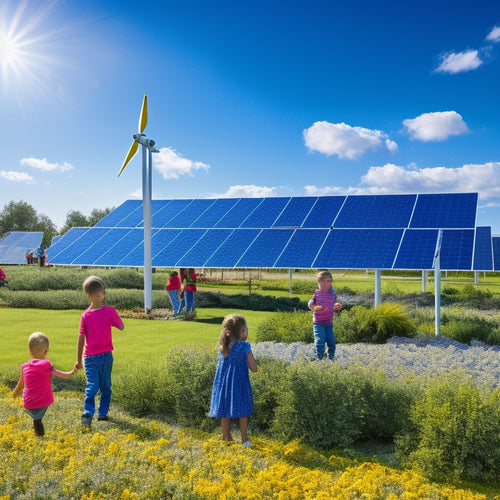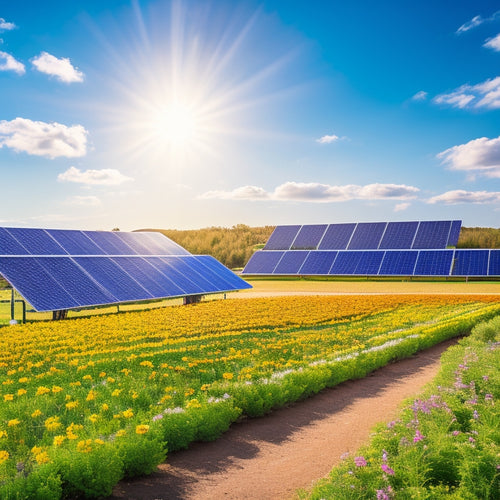
Best Solar Panels to Buy for Maximum Energy Efficiency
Share
When shopping for the best solar panels for maximum energy efficiency, you'll want to focus on top-tier brands with high-efficiency ratings, considering factors like cell temperature coefficient, panel efficiency, and module power density. Monocrystalline, polycrystalline, and bifacial panels all offer unique benefits, but prioritizing high efficiency ratings is essential for maximizing your investment returns. By understanding the subtleties of each type, you can choose the ideal panel for your needs and budget. As you weigh your options, keep in mind that there's more to investigate in the world of solar panels, and the right choice can yield significant long-term energy savings.
Key Takeaways
- Prioritize high-efficiency solar panels with ratings above 20% for maximum energy output, such as monocrystalline or bifacial panels.
- Look for low cell temperature coefficients, indicating better performance in high temperatures and reduced energy losses.
- Opt for panels with high module power density to generate more energy from smaller surface areas.
- Choose top-rated solar panel brands with lengthy warranties (typically 25 years or more) covering product defects and performance guarantees.
- Consider advanced thermal management techniques and low-loss connectors to minimize electrical losses and enhance energy production.
Top-Rated Solar Panel Brands
You're likely to find that top-rated solar panel brands consistently deliver high-quality products, boasting impressive energy efficiency and durability. These brands have built a reputation for excellence, backed by rigorous testing and certification from reputable organizations.
A key factor in their success is their commitment to using high-grade materials and state-of-the-art manufacturing techniques. This results in solar panels that can withstand harsh environmental conditions and maintain their performance over an extended period.
When evaluating top-rated solar panel brands, consider their brand reputation and warranty alternatives. A well-established brand with a proven track record is more likely to stand behind their products with thorough warranties.
Look for brands that offer lengthy warranties, typically 25 years or more, which cover both product defects and performance guarantees. This provides you with added peace of mind, knowing that your investment is protected in the unlikely event of a product failure.
Maximum Energy Output Factors
You'll want to contemplate three key factors when evaluating a solar panel's maximum energy output: its cell temperature coefficient, panel efficiency ratings, and module power density.
These factors are critical because they directly impact how much electricity your solar panel system can generate.
Cell Temperature Coefficient
When solar panels are exposed to high temperatures, their energy output takes a hit. This is because high temperatures reduce the panel's efficiency, leading to a decrease in energy production.
The cell temperature coefficient measures how well a solar panel performs in high-temperature conditions. A lower coefficient means the panel is more resistant to temperature-related energy losses.
To minimize energy losses, you'll want to look for solar panels with a low cell temperature coefficient. Here are some ways manufacturers achieve this:
-
Advanced thermal management techniques: These include using heat sinks, thermal interfaces, and other materials to dissipate heat away from the cells.
-
High-efficiency cells: These cells are designed to operate more efficiently at higher temperatures, reducing energy losses.
-
Cooling systems: Some panels incorporate active or passive cooling systems to keep the cells at a lower temperature.
- Low-temperature coefficients: Some manufacturers use specialized materials or designs that inherently have a lower temperature coefficient.
Panel Efficiency Ratings
High-temperature resistance is just one aspect of a solar panel's overall energy efficiency. You also need to take into account the panel's efficiency rating, which is the percentage of sunlight that's converted into electrical energy. This rating is essential in determining the maximum energy output of your solar panel system.
When evaluating solar panel technology, look for high-efficiency ratings, typically above 20%. These ratings are based on performance benchmarks set by industry standards, such as the International Electrotechnical Commission (IEC). A higher efficiency rating means more power output per unit area, resulting in more energy harvested from the same amount of sunlight.
To give you a better idea, a high-efficiency solar panel with a rating of 22% can produce up to 400 watts of power per hour, while a lower-efficiency panel with a rating of 18% might only produce around 300 watts per hour.
When choosing a solar panel, prioritize high efficiency ratings to maximize your energy output and get the most out of your investment.
Module Power Density
Module Power Density (Maximum Energy Output Factors)
When it comes to maximizing energy output, module power density plays a critical role. It refers to the amount of power generated per unit area of the solar panel. A higher module power density means more energy is produced from a smaller surface area, making it ideal for rooftops with limited space or for those who want to maximize their energy output.
To achieve high module power density, manufacturers focus on module design and installation techniques.
Here are four key factors that contribute to high module power density:
-
Cell efficiency: High-efficiency cells can pack more power into a smaller area.
-
Module design: Innovative module designs, such as bifacial or half-cut cells, can increase energy output.
-
Thermal management: Effective heat dissipation helps maintain peak operating temperatures, enhancing energy production.
- Low-loss connectors: Minimizing electrical losses through connectors and cables guarantees more energy reaches your system.
Efficiency Comparison Chart
You're likely considering multiple solar panel options, and one significant factor in making a decision is understanding their energy efficiency. This is vital because it directly impacts the amount of power your system can produce. To help you make an informed decision, we've compiled an efficiency comparison chart of popular solar panel types.
| Solar Panel Type | Efficiency Range |
|---|---|
| Monocrystalline | 20-22% |
| Polycrystalline | 18-20% |
| Thin-Film | 7-14% |
| Bifacial | 20-24% |
As you can see, monocrystalline and bifacial solar panels offer the highest efficiency rates, making them ideal for installations with limited space. Polycrystalline panels, on the other hand, provide a more affordable option without sacrificing too much efficiency. Thin-film panels, while less efficient, may be suitable for specific installation techniques or large-scale projects. When choosing a solar panel, consider your energy needs, available space, and budget to select the most efficient option for your situation.
Cost-Effective Solar Panels
When considering cost-effective solar panels, you'll want to prioritize budget-friendly options that still offer significant energy savings potential.
By choosing panels with lower upfront costs, you can save money on installation and still reap the benefits of renewable energy.
Additionally, looking for low-cost installation options, such as DIY-friendly systems or discounts from manufacturers, can further reduce your overall expenditure.
Budget-Friendly Options
Your wallet doesn't have to take a hit to leverage the power of the sun, as cost-effective solar panels can provide a reliable and efficient source of energy without breaking the bank.
You can enjoy the benefits of solar power without sacrificing your budget.
When it comes to budget-friendly options, you'll want to take into account the following affordable alternatives:
-
Polycrystalline solar panels: These panels are made from multiple silicon crystals, making them less expensive to produce than their monocrystalline counterparts.
-
Thin-film solar panels: These panels use a thin layer of photovoltaic material, reducing material costs and making them a more affordable option.
-
Bifacial solar panels: These panels can capture energy from both the front and back sides, increasing energy output while keeping costs low.
- DIY solar panel kits: These kits allow you to assemble and install your own solar panels, cutting out installation costs.
Keep in mind that you may be eligible for energy incentives, such as tax credits or rebates, which can further reduce the upfront cost of your solar panel system.
With these affordable options, you can start leveraging the power of the sun without draining your wallet.
Energy Savings Potential
Over 75% of homeowners who invest in solar panels do so to reduce their energy bills. By choosing the right solar panel system, you can greatly decrease your energy consumption and save money on your utility bills.
| Solar Panel Type | Energy Savings Potential |
| Monocrystalline Silicon | 15%-20% reduction in energy bills |
| Polycrystalline Silicon | 12%-18% reduction in energy bills |
| Thin-Film Solar Cells | 10%-15% reduction in energy bills |
| Bifacial Solar Panels | 18%-25% reduction in energy bills |
When considering solar panels, it's important to look beyond the initial cost and focus on the long-term energy savings potential. With the right system, you can enjoy considerable reductions in energy bills and even take advantage of solar incentives. By understanding your energy consumption patterns and choosing the most efficient solar panels, you can maximize your energy savings and get the most out of your investment.
Low-Cost Installation
Beyond the upfront cost of solar panels lies the vital aspect of installation costs, which can greatly impact your overall expenses. As you're considering investing in solar energy, it's essential to investigate ways to minimize these costs.
You can considerably reduce your installation expenses by taking advantage of incentive programs offered by the government and local utilities. These programs often provide rebates, tax credits, or low-interest loans to encourage the adoption of renewable energy sources.
To further cut down on installation costs, follow these tips:
- Opt for a smaller system: A smaller system requires less equipment and labor, resulting in lower costs.
- Choose a simple installation: Avoid complex installations that require additional hardware or custom designs.
- Select a local installer: Local installers often have lower labor costs and are more familiar with local building codes.
- Schedule installation during the off-season: Many installers offer discounts during the off-season to maintain a steady workflow.
Durability and Longevity Matters
A solar panel's durability and longevity are essential factors in determining its overall energy efficiency. You want a system that will withstand the elements and continue to generate power at ideal levels for years to come. When evaluating solar panels, look for weather resistance and material quality. A panel's ability to resist extreme temperatures, humidity, and weather conditions will directly impact its performance and lifespan.
You'll want to take into account the type of materials used in the panel's construction. High-quality materials will guarantee your system can withstand harsh environmental conditions, reducing the risk of degradation and failure.
Additionally, a durable panel will require less maintenance and repair, saving you time and money in the long run.
When researching solar panels, be sure to check the manufacturer's warranty and performance guarantees. A reputable manufacturer will stand behind their product, offering a thorough warranty that covers defects and performance issues.
Key Features to Look For
With a durable and long-lasting solar panel system in place, you can now focus on the key features that will optimize its energy efficiency.
When selecting the best solar panels for your needs, consider the following essential features:
-
High-efficiency cells: Look for panels with high-efficiency cells that can convert sunlight into electricity at a higher rate.
-
Panel aesthetics: Consider the design and appearance of the panels, ensuring they fit seamlessly into your home's design.
-
Installation warranties: Opt for panels with thorough installation warranties that cover labor and materials for an extended period.
- Temperature coefficient: Choose panels with a low temperature coefficient, which indicates how well they perform in high temperatures.
Frequently Asked Questions
Can I Install Solar Panels on a Rented Property?
You can install solar panels on a rented property, but you'll need your landlord's permission and may consider a solar lease; research your tenant rights to guarantee a mutually beneficial agreement that doesn't compromise your rental contract.
Do Solar Panels Work During Power Outages?
You're wondering if solar panels keep generating power during outages. Typically, they don't, as most systems sync with the grid and shut off for safety reasons. However, with a battery backup and a suitable inverter, you can enjoy continuous solar panel functionality during power outages.
Are Solar Panels Resistant to Hail Damage?
You'll be relieved to know that most solar panels are designed to withstand hail impact, with manufacturers testing their products to guarantee panel durability against extreme weather conditions, giving you peace of mind during intense storms.
Can I Use Solar Panels for My RV or Boat?
Set sail for energy independence! You can utilize the sun's power for your RV or boat with RV solar or boat solar panels, designed to withstand harsh marine environments and provide reliable energy on the move.
Do Solar Panels Increase My Property's Value?
You'll likely see an increase in your property's value, thanks to solar panels, which can enhance your home's appraisal by up to 17%. Plus, you'll benefit from solar incentives, like tax credits, making your eco-friendly upgrade a savvy investment.
Conclusion
As you utilize the power of the sun, remember that maximum energy efficiency is within your grasp. You've now got the inside scoop on the top-rated solar panel brands, the factors that enhance output, and the features that matter. With this knowledge, you'll be able to tap into the full potential of solar energy, watching your savings soar like a bird taking flight. So, go ahead and shine bright with the best solar panels, illuminating a path to a greener, more sustainable future.
Related Posts
-

Solar Power for Community Energy Independence
Solar power is essential for your community's energy independence, offering both environmental and economic benefits....
-

High-Performance Solar Solutions for Sustainable Living
High-performance solar solutions are your gateway to sustainable living, maximizing energy efficiency while considera...
-

Energy-Efficient Heating and Cooling Appliances
Energy-efficient heating and cooling appliances can cut your energy bills markedly. By opting for models with high En...


